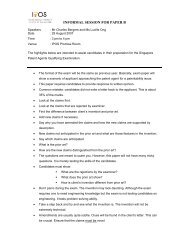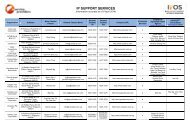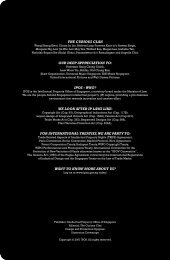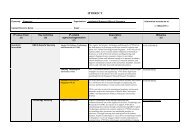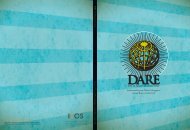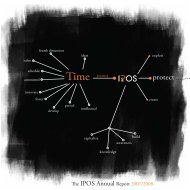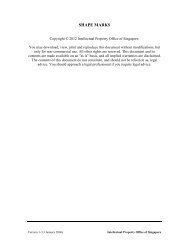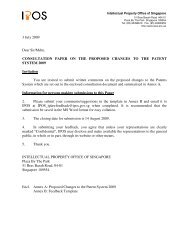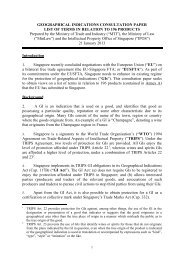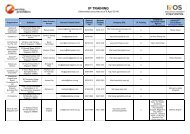Here - Intellectual Property Office of Singapore
Here - Intellectual Property Office of Singapore
Here - Intellectual Property Office of Singapore
Create successful ePaper yourself
Turn your PDF publications into a flip-book with our unique Google optimized e-Paper software.
2 - OWNERSHIP AND RIGHTS<br />
Enforcement <strong>of</strong> Registered Trade Mark Rights<br />
Once an infringement <strong>of</strong> a registered trade mark is established, the owner can enforce his rights as<br />
conferred by the Trade Marks Act. He can take legal action against the infringing party by seeking relief<br />
in the form <strong>of</strong> an injunction and either demanding for the pr<strong>of</strong>its gained by the infringing party at his<br />
expense or seeking damages for the loss suffered.<br />
When awarding damages, the Court may also award on account <strong>of</strong> pr<strong>of</strong>its attributable to the infringement<br />
that have not been taken into account in computing the damages.<br />
In an infringement action involving the use <strong>of</strong> a counterfeit trade mark in relation to goods or services, the<br />
owner <strong>of</strong> the registered trade mark has an additional alternative remedy <strong>of</strong> statutory damages.<br />
>> A counterfeit trade mark is any sign that is identical with or so similar to the registered trade mark<br />
as to be calculated to deceive and is applied to goods or services without the consent <strong>of</strong> the owner<br />
to falsely represent the goods or services to be the genuine goods or services <strong>of</strong> the owner <strong>of</strong> the<br />
registered trade mark.<br />
Making False Representation – A Criminal Offence<br />
It is a criminal <strong>of</strong>fence to falsely represent a trade mark as registered when it is not registered or if it is<br />
pending registration, or make a false representation as to the goods or services for which a trade mark is<br />
registered.<br />
Trade Marks and Internet Domain Names<br />
The Internet has become an important marketing channel and trading platform for products and services<br />
in recent years.<br />
As marketers continue to exploit their registered trade marks on the Internet, domain names have<br />
inevitably become part <strong>of</strong> their invaluable brand assets.<br />
In practice, domain names are registered on a first-come-first-served basis. If a trade mark has the<br />
potential <strong>of</strong> becoming valuable, the unscrupulous may decide to register the domain name using the<br />
trade mark name and later <strong>of</strong>fer it to the trade mark owner in exchange for a huge sum <strong>of</strong> money. To<br />
avoid being victims <strong>of</strong> these so-called 'cybersquatters', a registered trade mark owner should register his<br />
domain name before anyone else does.<br />
>> A domain name is an electronic address that identifies a location on the Internet, somewhat like<br />
street names in cities, e.g. the domain name <strong>of</strong> <strong>Intellectual</strong> <strong>Property</strong> <strong>Office</strong> <strong>of</strong> <strong>Singapore</strong> (acronym<br />
IPOS) is www.ipos.gov.sg.<br />
In <strong>Singapore</strong>, local domain names (those with the extension ".sg") are assigned by the Registrars<br />
accredited by the <strong>Singapore</strong> Network Information Centre (SGNIC) www.nic.net.sg. On request and<br />
upon payment <strong>of</strong> a fee, the Registrar will assign your company a domain name. As the registration<br />
is administered on a first-come-first-served basis, it may be possible that someone else would have<br />
registered the domain name before you.<br />
7



